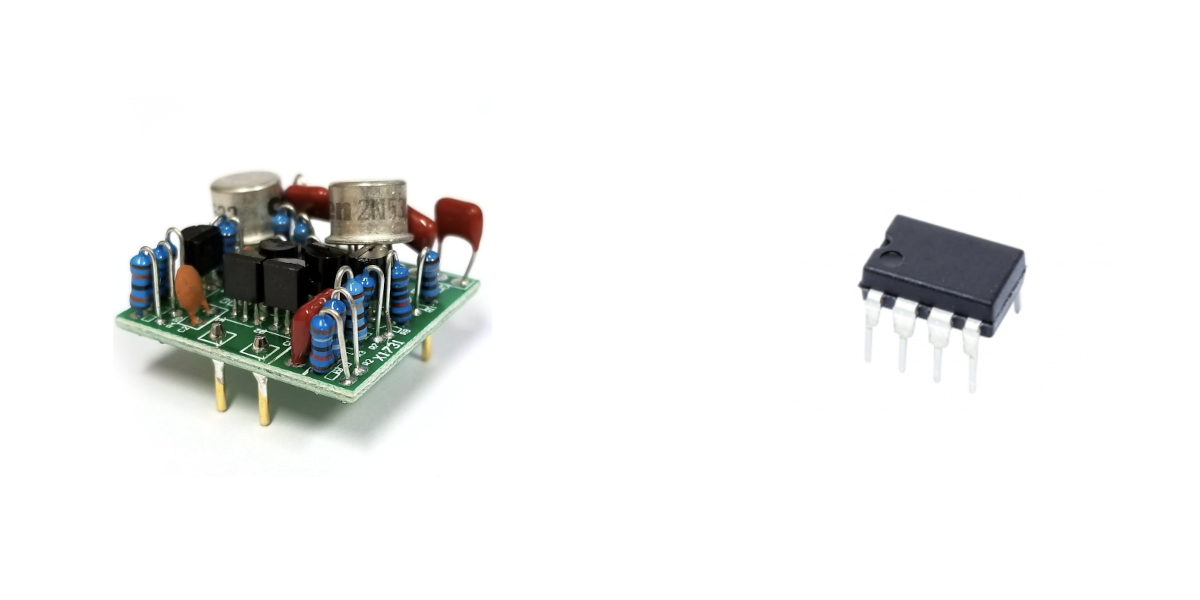If you’ve read much about boutique and vintage microphone preamp (or microphone) designs, you may have come across the word “discrete” from time-to-time. You will almost always see it listed as a distinct benefit in the world of audio, but what does it really mean? Are there any advantages to whatever the opposite of “discrete” is, if manufacturers like Warm Audio seem to be using that term to denote serious value? Read on and all will be answered!
Before we begin in earnest, it’s important to note the difference between the words “discrete” and “discreet” – because they sound alike but have completely different meanings. In general conversation, when someone asks you to be “discreet” they’re basically asking you to not share what you know with a bunch of other people, or to carry about in a way that is unobtrusive or careful. However, “discrete” means “separate and distinct” – and that’s a totally different ballgame when it comes to electronics!
In the world of audio, when we say “discrete” what we’re really saying is that the audio circuit in question is made up of a large number of small individual components. The opposite of this design idea is referred to as “monolithic”, which just means that everything important is contained within a single enclosure, like a microchip. So if you compare a microphone preamp to a plate of pasta – follow me here! – a discrete design would have a full bowl of small individual pieces of pasta (think penne or orzo) to make up the entire meal, where the monolithic design might contain only one or two larger pieces (think manicotti) to feed the same person.

Before you ask, yes, you’re right. I think about food far too much in normal life, and I had lunch right before sitting down to write this 🙂
So a discrete design uses a bunch of individual components to accomplish the same thing that the single chip does. Which idea is better? Are there advantages to either design philosophy? Read on!
The reality is that we would barely recognize modern life if the stuff we use everyday didn’t utilize monolithic designs. Seriously. Almost everything that we have come to rely on to accomplish what we need to every day – cell phones, laptops, iPads, smart watches, automobiles, televisions, etc – uses a complex series of monolithic components put together to create the end product. Why, you ask? Because monolithic designs are far smaller, generate less heat and are less expensive than the same thing made with individual discrete components. Not only that, many devices we rely on daily couldn’t be manufactured in the first place without monolithic design.
That sounds great for a mobile phone or a television, doesn’t it? The size and affordability of cell phones and tv’s is hyper-important for many aspects of modern life, and if your cell phone had to be 100 times the size it is now to work you wouldn’t use it, would you? In many ways, the manner in which we intend to use a device determines how it should be designed.
BUT (and it’s a Sir Mix A Lot-sized ‘but’), should your microphone preamp be built in the same way that your cell phone is? Just because it works great for your television, should your vintage-inspired microphone follow the same design aesthetic? As far as I’m concerned, the answer is an emphatic “no”, and I’ll explain why.
First, it’s important to remember that microphone preamps and equalizers don’t need to do all of the stuff that our iPads and phones do. They don’t need to play back videos or allow for live streaming, and they don’t need to take pictures or fetch email – they just need to make our microphones sound phenomenal as they amplify them.
For all of the benefits that monolithic design can offer in manufacturing, discrete circuits offer some distinct advantages over monolithic when we’re talking about audio. Perhaps the most important benefit would be that we can choose the absolute best component for every single point in the circuit, where monolithic chips have to fit everything on the same single piece of silicon, and that requires the chip maker to compromise ultimate performance for ease of construction.
So in a discrete mic preamp we can choose the best transistors, resistors, capacitors, inductors and transformers to amplify our microphone signals in the best way available, and every single component can be optimized for low noise and optimum audio behavior. When you start optimizing every tiny part of the circuit it makes a huge difference down the line, because we can achieve lower noise, higher power output and handling, and better audio performance than a monolithic design can.
Don’t take it from me, take it from acclaimed audio gear designer John Hardy (whose 990C+ discrete op-amp is an industry favorite) as he talks about discrete op-amp design:
“A discrete op-amp is made from individual (discrete) transistors, diodes, resistors, capacitors, and, occasionally, inductors…each diverse component is fabricated on a manufacturing line that is fully optimized for that specific part. Therefore, each component is the very best it can be.”
As an example of the difference in real audio life, check out our Warm Audio X731 discrete op-amp (which lives in our WA12MKII and Tonebeast preamps) versus a typical OPA604 monolithic op-amp chip. You can see all of the individual discrete components that are soldered by hand onto a single board on the X731, whereas the OPA604 is all enclosed.

Because the X731 is discrete, it performs better in our WA12MKII and Tonebeast preamps than a single monolithic package would – it has lower noise and higher power handling, and has the ability to help the preamp saturate and make things sound bigger and more important.
In general, all of the products that we make at Warm Audio – both the rack gear and the microphones themselves – follow a discrete methodology. Yes, it requires more power and generates a bit of heat here and there, but the sonic advantages are too numerous for us to ignore. We truly care about providing customers with the best tools for recording at an affordable price, and in the end the sound tells the story. If it sounds good it IS good, and it doesn’t really matter what it took to get it there.
And geez, a new iPhone 13 is reported to have some 8.5 billion transistors in it, so if each one of those were the same size as the transistors on our X731 op-amp, your new iPhone would be roughly the size of the Empire State Building. Crazy! We definitely need monolithic design in our lives, I would just rather that my vocal tracks didn’t take advantage of it.
Until next time!
